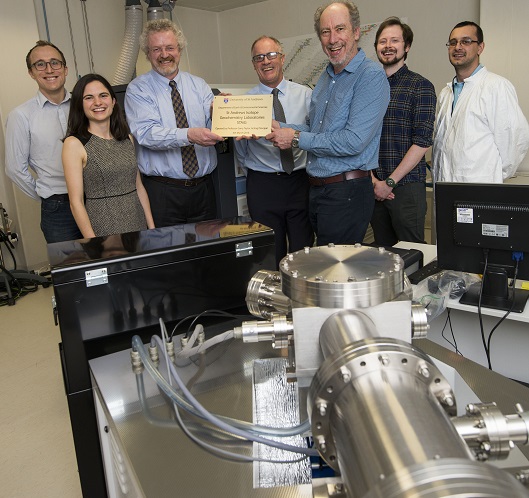New laboratory promises insights into evolution of Earth and life

The composition of the early solar system, the great secrets of Earth’s evolution, and understanding past and present climate change are just some of the areas of research that will benefit from the official opening today (Friday 4 March 2016) of a new isotope geochemistry laboratory at the University of St Andrews.
The Department of Earth and Environmental Sciences’ new £2 million laboratory space is part of the University’s efforts to combine world-leading scientists with the finest facilities. Isotope geochemistry is a field of research that uses the chemical content of materials to further our understanding of climate and environmental change, Earth’s natural resources, and the history and evolution of the Earth and the Solar System.
The new St Andrews isotope geochemistry (STAiG) facilities boast two clean laboratories supplied with highly purified air, to ensure that samples are not contaminated by dust and other impurities during handling and preparation for analysis. These laboratories house five state-of-the-art mass spectrometers which enable extremely precise chemical analyses to be made on materials such as moon rocks, meteorites, corals, ice cores and sediments.
Professor Peter Cawood, Head of Department of Earth and Environmental Sciences, said: “These new laboratory facilities have unique capabilities that will drive science forward, both in the earth sciences and across disciplines including biological, chemical, and material sciences.”
Acting Principal and Vice-Chancellor of the University of St Andrews Professor Garry Taylor officially opened the facilities and Professor Alex Halliday of Oxford University delivered a keynote lecture entitled ‘Isotope ratio mass spectrometry from planet formation to medicine’ following the official opening.
Professor Alex Halliday FRS said: “Isotopic measurements have revolutionised our understanding of the Earth and Solar System. It is great to see the University of St Andrews taking a lead and developing new research programmes in this key area.”
Notes to news editors
The STAiG laboratories were joint-funded by the University of St Andrews and the Natural Environment Research Council.
The new facilities consist of two Class-100 metal-free clean rooms, as well as analytical facilities including three Multi-Collector Inductively Coupled Plasma Mass Spectrometers (two Nu Plasma and one Thermo Scientific Neptune Plus instruments) and two Thermo MAT253 gas source mass spectrometers.
The opening event was followed by an interdisciplinary conference on the use of isotopes across the sciences, partially funded by EPSRC.
Photos are available from the Press Office on request – contact 01334 462 530 or email [email protected].
Category Research